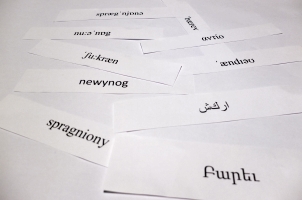This lesson forces learners to use accurate classroom language and works well with lower level learners.
It is also a good activity to use with a group of new learners or for CELTA/TESOL teaching practice.
Uber-busy teachers can download the lesson plan here. How-to-say-it1.pdf (368 downloads)
Procedure
1) Ask the learners
What’s difficult about English?
Elicit responses.
2) Tell the learners that ‘People often find English difficult because of the pronunciation – how we say the words. Why is this difficult?’. Elicit responses.
3) Tell the learners ‘This is because English has words from several different
languages, mainly from French (Latin), from German (AngloSaxon) but also from other languages such as Greek’.
4) Say ‘I will give you some words and I want you to answer some questions. Please write these questions down. The questions are:
Which part of the world does this language come from?
What language is it?’
5) Say ‘Here are some phrases to help you with the pronunciation of
these words – can you work out how to say these words?’
6) Give each pair of learners a set of the words that you have cut up into separate
strips, and give each learner a set of classroom language phrases (e.g. ‘How is it said?’).
7) Learners then discuss the questions for 5-10 minutes. Teacher monitors.
8) Learners feedback answers.
9) Tell the learners ‘I will help you with the pronunciation now. Here are some sound symbols that help you learn how to say the word. Can you put them together with the words?’
10) After learners have done this – give help if needed – elicit their responses to the
original questions and tell the learners the pronunciation, meaning and where the word comes from.
11) Drill and repeat the classroom language with the learners, remind them to use this in class when they don’t know how to pronounce a word.
12) Take back the foreign word cards (but leave the classroom language vocabulary
with the learners) and carry on with your lesson. At stages throughout the lesson, hold up the cards again and ask them ‘How is this word said?’, ‘How do you pronounce this?’ and so on.
Here are the foreign words and their meanings:
Բարեւ (Barev) – ‘Hello’ in Armenian
αντίο (andío) – ‘Goodbye’ in Greek
newynog – ‘Hungry’ in Welsh
spragniony – ‘Thirsty’ in Polish
شكرا (shukran) – ‘Thank you’ in Arabia
Conclusion
I hope that you found this lesson useful – drop me a line if you have any ‘hacks’ or improvements.
Cheers,
paul
Images
We don’t speak, we don’t laught. Arkangel on flickr. CC license 2.0.

